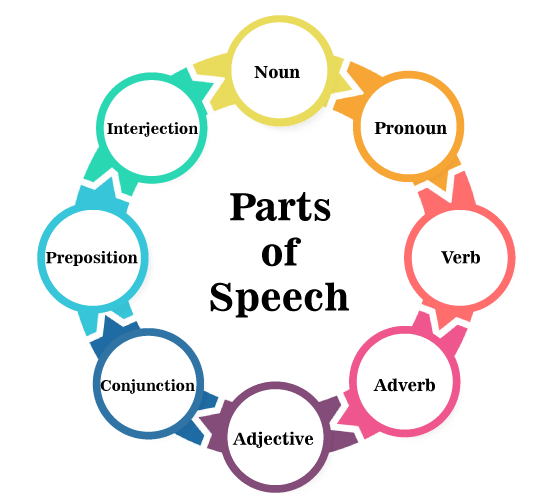Parts of Speech with Examples and Rules
What do you mean by parts of speech?
Language is the backbone of human communication. One of the fundamental aspects of language structure is the classification of words into different categories based on their grammatical roles and functions. These classes, are known as parts of speech.
Every word in English is one of the eight parts of speech; or you can say in simple English that every sentence of English is made up of different parts of speech. There are eight parts of speech which together can make-up a whole sentence.
In this article, we’ll delve into the different parts of speech, exploring their definitions, functions, and examples.
How many parts of speech are present in English?
Parts of speech are different words in a sentence that plays different roles. The roll of a single word can be changed in other sentence, so it can change its class (part of speech) accordingly.
Let’s try to learn the eight parts of speech with definitions and examples. The eight parts of speech include a noun, a pronoun, a verb, an adverb, an adjective, a preposition, a conjunction and an interjection.
Let’s describe all the parts of speech one by one.
-
Noun:
A noun is a naming word that represent people, places, things, or ideas. They serve as the subject or object of a sentence and can be concrete (e.g., book, table, cat) or abstract (e.g., love, courage, democracy). Nouns can also be categorized further into common nouns (used for general names or things e.g., car, city) and proper nouns (used for specific names or things e.g., Toyota, Paris), where proper nouns typically beginning with a capital letter.
Examples
Marry lives in Paris.
She has a fear of darkness.
-
Pronoun:
Pronouns are words that we use to replace nouns to avoid repetition. Examples of pronouns include I, me, he, she, it, they, them, we, us, you and yours.
Examples
Steve lives in London. He used to go late for the job daily. I’ll ask him to come to the office on time tomorrow.
-
Verb:
Verbs are the words that express an action, occurrence, or state of being. They form the core of a sentence and are essential for conveying what is happening (by the noun or by the subject of that sentence). But some verbs are not action words (like, to love, to be). Verbs can be categorized into various forms such as action verbs (run, eat, dance), helping verbs (is, have, will), and linking verbs (seem, become, appear).
Examples
I like to read books.
She plays cricket well.
You should run as fast as you can.
Sometimes a sentence is made up of more than one verb, e.g.
She can (helping verb) sing (action verb) a song.
-
Adjective:
Adjectives are words that modify or describe nouns or pronouns, providing more information about their qualities or attributes. They answer questions like “What kind?” or “Which one?” some examples of adjectives include beautiful, tall, intelligent, blue etc.
Examples
The weatherer is hot today.
The blue dress you wore last night was pretty.
-
Adverb:
Adverbs are words that modify or describe verbs, adjectives, or other adverbs, indicating manner, time, place, degree, or frequency. They often answer questions such as “How?” “When?” “Where?” or “To what extent?” Adverbs can be formed by adding the suffix “-ly” to adjectives, such as quickly, slowly, or gracefully.
Examples
He arrived late for the class. (Adverb of time)
She is very lazy. (Adverb of degree)
My dad reads newspaper everyday. (Adverb of frequency)
My teacher speaks softly during the class. (Adverb of manner)
Did you go there to pick up the parcel. (Adverb of place)
-
Prepositions:
Words that show the connection between nouns or pronouns and other words of a sentence are called the pronouns. They typically indicate location, time, direction, or manner. Common prepositions include in, on, at, by, between, and among.
My sister asked me to go to the store near my college.
He walked up the stairs to go to the store.
-
Conjunction:
Words that connect different words, phrases, or clauses within a sentence are called conjunctions. They serve to coordinate or join different elements together. Examples of conjunctions include and, but, or, so, yet, and for.
Examples
I like carrot juice and orange juice, but I don’t like to eat them.
He went to the museum or he went to the library?
-
Interjection:
Interjections are words or phrases used to express emotions or sudden bursts of feeling. They often used alone and are punctuated with an exclamation mark. Examples include Wow! Oh! Ouch! Hey! etc.
Understanding the parts of speech is essential for developing strong writing and communication skills. By recognizing and utilizing these building blocks effectively, you can construct clear and comprehensible sentences that convey your intended meaning with precision. Whether you’re learning a new language or seeking to enhance your mastery of your native tongue, a solid understanding of the parts of speech lays the groundwork for successful communication.

If you like this article and want to read more articles please use below mentioned link.



